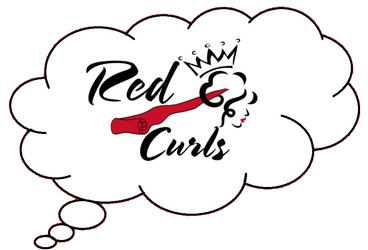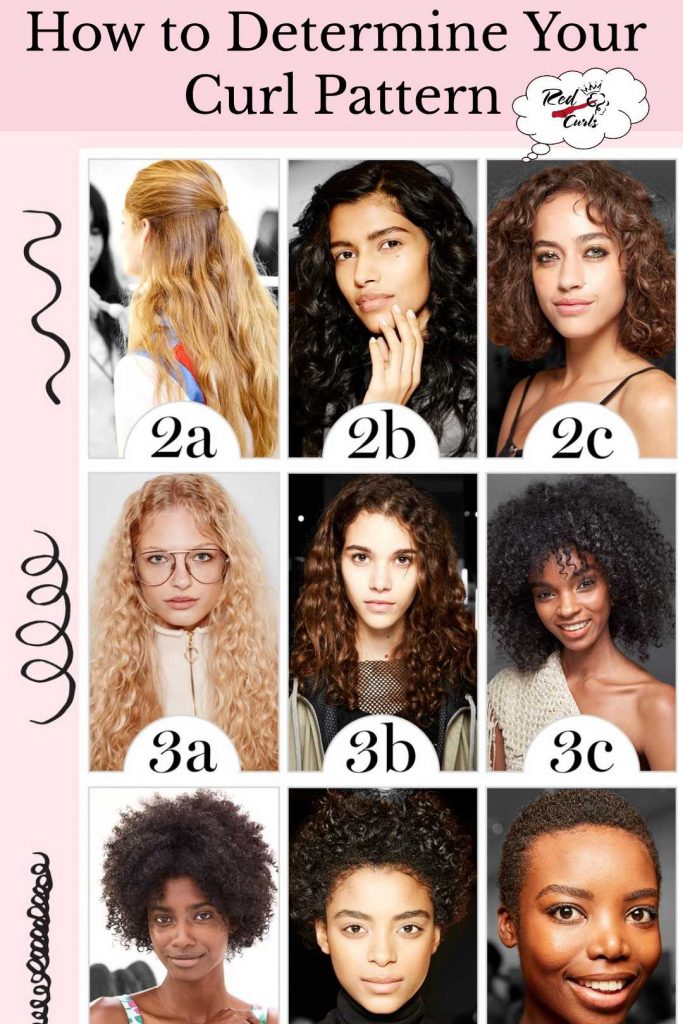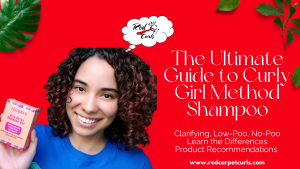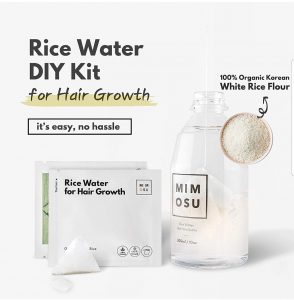My beautiful #RedCarpetCurlsRoyalty,
Determining curl type can feel a bit overwhelming when we are presented with charts. I mean let’s be honest who on God’s green Earth really describes their hair using a number and letter? Before I started the Curly Girl Method, when someone asked me my hair type, I would say, “Um…black hair?” Yes, not my finest hour.
Determining your curl type can be overwhelming but this article is here to help guide you through the jungle that is the Curly Girl Method sector of the internet.
Let’s get down to what you really need to know.
What is Curl Type and Why is it Important?
All hair is different, yet, the haircare market seems to be the last to get the memo. Most products on the market are full of bad chemicals and are not targeted toward specific textures.
The Curl Pattern Chart was first created by hairstylist Andre Walker. It separates hair types by texture and density. Most curl pattern charts, such as NaturallyCurly.com, focuses on type 2 (wavy), type 3 (curly) and type 4 (coily). The subclassifications – from A to C – are based upon the diameter of the wave, curl or coil.

Determining your curl pattern type will help you when it comes to choosing products that work best for your hair’s needs. Your curl pattern determines how your textured hair grows. Once you know that, with a little trial and error, you will find what kind of products work best for your hair without weighing them down.
One of the most important things to understand about your Curly Girl Method journey is realizing it is individualized. You will notice most of what we consider “fact” in regards to our hair has no scientific backing at all. So it’s hard to find a good launching point to start the method. As you continue your journey, you will find you will make fewer mistakes, and this will help save you money on products (becoming a product junkie gets very pricey) and it will save you time.
That is why identifying the curl pattern can help narrow down your searching net. By focusing on example routines from influencers or others based on your curl type, there’s a much better chance the product that worked for the influencer with your hair type will work for you as well.
What Should I Know When Trying to Correctly Identify My Curl Type?
One thing to remember is while we call this a curl type, all this chart really is meant to do is showcase different examples of textured hair. Not all textured hair is curly, we also have wavy, kinky, Afro, etc.
When trying to determine your curl type do not cement yourself to one curl type. When we all begin our Curly Girl Method journey we all start with damaged hair. Many people will start with wavy hair and once a year or two has passed, as their hair health improves, they realize their pattern has changed and tightened.
It is possible to change curl types while transitioning. I started my journey as a 2c/3a (yes, one head of hair can contain more than one pattern) after nearly three years of caring for my hair properly, my true pattern has emerged. My hair is actually a combination of 3a/3b.

Your damaged hair will change, it will for some, become thicker, and the pattern may get tighter. This is not a promise, as your curl type is determined by your genetics. Meaning if you did not have textured hair as a child, you cannot all of a sudden grow textured hair. If you had straight hair all your life you will have straight hair. Now there are rare exceptions to the rule, but for the most part, if you were born with some kind of texture, it’s possible to get it back. But you cannot grow what you never had.
One thing to remember about curl types is that curls are a hereditary trait! If your parents have curly hair, or even if just one parent has curly hair, you’ll end up with either wavy or curly hair yourself.
The shape of our hair follicle determines the texture of your hair. If you were to look at the follicle of straight hair, you would find it is perfectly round. The follicle of curly hair adopts an oval shape. The flatter the oval is, the curlier the hair will be.
Type 2 – Wavy Hair

Wavy hair tends to form in a loose S-shape, but the hair type can possess similar characteristics to straight hair (a slight, smooth wave) or curly hair (a tighter S-shape). Like most hair types, wavy hair can be fine, medium-textured or thick and coarse.
Scientists don’t know why different hair types develop, but the shape of the hair follicle matters (yours is wavy), as does the way hair proteins (keratin) are clustered in the hair shaft. Your type can change, so your wavy locks may turn to curls later in life.
The fibers of wavy hair are semi-oval shaped, making it mostly round, but twisting ever so slightly upon the other follicle.
Wavy hair has the most sheen compared to type 3 or type 4 hair.
Women with wavy hair typically use mousses and leave-in serums, rather than creams and gels and are generally most concerned with reducing their frizz and finding products that will give their waves light hold without weighing them down.
Type 2 hair is typically more flat at the root and lays close to the head, getting curlier from the ears down. Wavy hair is more prone to frizz, so humectants can be an absolute essential for those with this hair type.
As I mentioned before each curl type is subclassified by density.
Wavy Hair – 2a

2a hair type typically showcases waves that are fine and thin. The wave can be of loose and tousled texture. This hair type lacks volume and definition, which is where product selection will be crucial. Products that are too heavy can easily weigh down the hair and make it appear straight. Look into lighter products like refresh sprays, hairsprays, mousses, etc.
Wavy Hair – 2b

2b hair type typically showcases hair that appears straight at the roots and then falls into a more defined S-shaped wave from the mid-lengths to the ends of the hair. It is a medium texture with some frizz at the crown of the head.
Wavy Hair – 2c
2c hair type typically showcases a more defined wave that starts at the roots. You can see some curling toward the ends of the hair but the wave pattern will be more defined than the curl. This texture is typically thick and coarse and is prone to frizzing. This hair type especially benefits from enhancing your weekly deep conditioning treatment to reduce the frizz. Read more about that here.
Type 3 – Curly Hair

Type 3 hair, also known as curly hair develops its curl from the shape of your hair follicle. The fibers of the hair are oval. Curly hair is asymmetrical making drops in different directions on all sides of the scalp. Curly hair loses sheen if it is manipulated with chemicals or heat. Proper hydration and protein/moisture balance are key to curly hair.
Type 3 hair ranges from a loose curl to a tight curl. It is common for those with curly hair to have a combination of textures on their head. Curly hair’s pattern is more defined and springy. Curly hair has more volume at the root than wavy hair. Frizz is the most common issue plaguing curly hair, especially in high humidity conditions.
Scrunching is a key technique in helping define the pattern of curly hair. If you have looser or less defined curls try scrunching at the end of your styling.

If you have a tighter curl pattern and battle with shrinkage, do not scrunch, instead, blot the hair in order to elongate the curl.
Curly Hair – 3a

3a consists of big, loose curls and spirals similar in circumference to a piece of sidewalk chalk. This curl type is largest in diameter and can also have a mix of wavy pieces. Curls tend to be shiny and have a defined S-shaped curl. This type is prone to frizz, finger-coils during the transition phase can help give a more unified look till the damaged hair heals. 3a hair is defined, springy and has a potential for a lot of body and shine. Making sure your hair is moisturized at all times is a universal hair care rule for all curly hair types because your strands are naturally drier. Scrunch when styling hair to encourage more definition.
Curly Hair – 3b

This hair type offers a tighter and springy curl, can vary from ringlets to corkscrews. This hair type is very voluminous and has the circumference of a sharpie marker. 3b tends to be more coarse and dense. Type 3b hair generally isn’t particularly shiny. Because this hair type tends to frizz easily, use gels and styling creams with extra moisture and serious frizz control. The most ideal 3b natural hairstyles are those that involve little manipulation. The wash and go will be your go-to hairstyle and one of your easiest. If you master moisturization, you won’t have much problem wearing your hair down after a shower.
Curly Hair – 3c

3c hair often is referred to as curly-coily and tends to be very dense, tightly packed corkscrews that are the circumference of a pencil or a straw. Type 3c hair tends to experience the most volume, but also the most shrinkage of curls. Do not scrunch this hair type as it will lead to shrinkage, instead to elongate the curl, simply blot hair. 3c tends to dry out faster since the curl pattern keeps the sebum from going all the way down the strands. The best thing to do is set up a consistent deep conditioning schedule and focus on mastering your moisture levels to keep curls looking their best.
Type 4 – Extremely Curly/ Kinky/ Coily Hair

Coily hair, also known as type 4 hair, develops its structure from the shape of the cortex. The fibers of coily hair are flat, unlike curly hair which is oval. The flatter the hair shaft gets, the more disulfide bonds occur between hair proteins, making it squiggle in “S” and “Z” shapes on the side of the scalp.
Tightly coiled hair is fine and thin or wiry and coarse. With densely packed coils, despite the hair looking very thick, this is the most fragile hair type. Because it has the fewest cuticle layers to protect it from drying out which makes coils more prone to damage and breakage from styling (either with or without heat) and chemical treatments like dyes and relaxers.
A misconception about type 4 hair is that it does not grow. the truth is it grows at the same rate as other hair, but this hair type can shrink up to 75%! Type 4 hair ranges from tightly coiled with a visible “S”- pattern the size of a crochet needle, to a sharp angle like the letter “Z” the circumference of a pen spring.
The tighter the coil the less definition and more shrinkage the hair will have. Coiled hair should be treated in a gentle manner. A person should avoid harsh cleansers, use products with tons of moisture, avoid high heat, cleanse gently, and detangle softly if possible avoid combs and brushes.
Coily Hair – 4a

Type 4A is described as having a more definite curl pattern than subtype 4B. It is not only tightly curled but when stretched out it makes more of an S shape more like curly hair. Generally speaking, 4b hair retains moisture fairly well, but as with most curly hair types can still be prone to dryness. Being that this hair type has a naturally defined curl pattern wash n’ go styles may be a great option as it can be easily achieved with the right product and technique. 4a is prone to dryness but its moisture retention capacity is hair than the other hair types.
Coily Hair – 4b

Type 4b has a “z” shape pattern and has a more fluffy cottony appearance. Due to the bends and curves in the hair strand, it is highly susceptible to dryness and breakage. This hair type shrinks up to 70% so without stretching out the hair it will appear shorter than it actually is. Type 4b is very diverse in texture, it ranges from a fine texture and scarce density to coarse texture and densely packed hair strands. Since this hair type is so fragile it can benefit from protective styles such as braids, twists, etc. Avoid tension on hair strands such as tight hairstyles (E.g. tight buns) Deep condition regularly to avoid breakage.
Coily Hair – 4c

4c hair looks similar to 4b hair type only it is more tightly coiled. In its raw state (no products added and freshly washed) it does not have a defined curl pattern. Coils have to be defined by either twisting, braiding, or shingling through the strands. Many 4c naturals have shrinkage up to 70% or more. 4C hair type does best with products on the heavier creamier side. The hair strands do not clump easily, the only way to do so is by applying special products and techniques. In order to grow 4c hair long, you have to be very gentle with it as it is the most fragile hair type. Never brush with a bristle brush because it can catch the ends and break the hair. Should be protected when sleeping at night with satin or silk. Deep condition regularly.
How to Determine Your Own Curl Pattern?
Determining your curl type is something most of us just guess at in the beginning. We take a look at the curl type charts and to the best of our abilities try to match our own hair to the charts. This is not always practical as curl patterns can change once the hair heals.
One of the better suggestions I can give when trying to figure out your curl type is by taking the Naturally Curly website quiz on hair types. It’s pretty astonishing how on-the-ball this quiz is most of the time. It correctly gave me my hair type on the first try. It never hurts to try because the results are generated from all your answers helping it narrow it down a bit more.
What Else Do I Need to Know About My Hair?
Right now the best way we determine curl pattern is by comparing our curls to the charts. Now knowing your curl type isn’t the only important piece of information you need before purchasing products and trying new techniques.
You also need to know other things like porosity – the way your hair absorbs water and other products. Knowing your porosity changes the kinds of products you need and even your deep conditioning practices. That is why we need to turn to science! Trust me this will save you SO much time and money along your journey. You won’t have to waste money on products that didn’t work. You will know exactly what you need.
MyManeBio is a small online lab that preforms complete hair analysis. After you purchase your analysis, the company sends you a hair collection packet. You put your hair in the bag provided and drop the pre-addressed, pre-stamped envelope in the mail. They send you an email when they’ve received your hair. After your analysis is complete, they send your Hair Bio to the email address you provided. The analysis provides you with your porosity, width, elasticity, and overall health of your hair.
According to the website, here is what the full analysis entails:
What we do for this analysis: Measure the porosity, elasticity, width, and overall health of your hair including comparing hair measurements and condition at the root vs the tip. Note any findings related to the overall type (straight, wavy, curly, kinky) of your hair. Provide at least five pictures of your hair taken through the microscope.
Review the ingredients of up to five products you are currently using to determine compatibility with your hair type, hair goals, and climate where you live (i.e., humidity and dew points). Give recommendations for hair care product ingredients that should be avoided based on your specific hair type. Make step by step recommendations for cleansing, conditioning, and styling techniques to achieve your hair goals and help you embrace your natural hair texture. Address specific lifestyle and hobbies that may be affecting your satisfaction with your hair. Discuss the possible effects of the type of water you use to cleanse and condition your hair.”
Final Thoughts From Red Carpet Curls
The MyManeBio test is a completely optional but super helpful step to take along your Curly Girl Method journey. As you can see from how we determine our curl type, there isn’t much concrete science-based theory out there when it comes to curly hair, that is why I take advantage of every opportunity to learn new information that is backed by science, not internet heresay.
Learning your curl type is one of the most valuable pieces of information to have when you start your Curly Girl Method Journey. By observing routines from others with your curl pattern it can help set you on the right path to finding the right products and methods for your perfect frizz-free hair day.
Do you know your curl type? Comment below!




